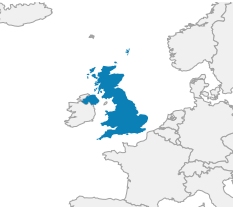Home / Fact sheets / United Kingdom / Population fact sheet
The World Bank (2023)
World Health Organization (2021)
UNDP Human Development Report (2022)
World Health Organization (2019)
GLOBOCAN (2022)
Check also the following factsheets: Breast, Cervical, Colorectal
Country fact sheet: United Kingdom
| - Total population: | 67 184 072 |
| - Female population: | 33 971 725 |
| - Male population: | 33 212 347 |
Health Expenditure
| - Total per capita (US$): | 5 738.5 |
| - Out-of-pocket (% of total expenditure on health): | 13.5 |
| - UHC Service Coverage Index: | 88 |
Human Development Index
| - HDI: | 0.94 |
| - Category: | Very high |
Geography
 |
Life Expectancy at Birth
| - Total population (years): | 81.4 |
| - Female population (years): | 83.0 |
| - Male population (years): | 79.8 |
Cancer Burden
| - Overall cancer incidence (rate per 100 000 persons per year): | 307.8 |
| - Overall cancer mortality (rate per 100 000 persons per year): | 98.3 |
| - Most common cancer site by incidence for females (rate per 100 000 persons per year): | Breast (94.0) |
| - Most common cancer site by mortality for females (rate per 100 000 persons per year): | Lung (17.4) |
| - Most common cancer site by incidence for males (rate per 100 000 persons per year): | Prostate (74.0) |
| - Most common cancer site by mortality for males (rate per 100 000 persons per year): | Lung (21.8) |
| - GLOBOCAN 2020 population fact sheet |
Check also the following factsheets: Breast, Cervical, Colorectal

